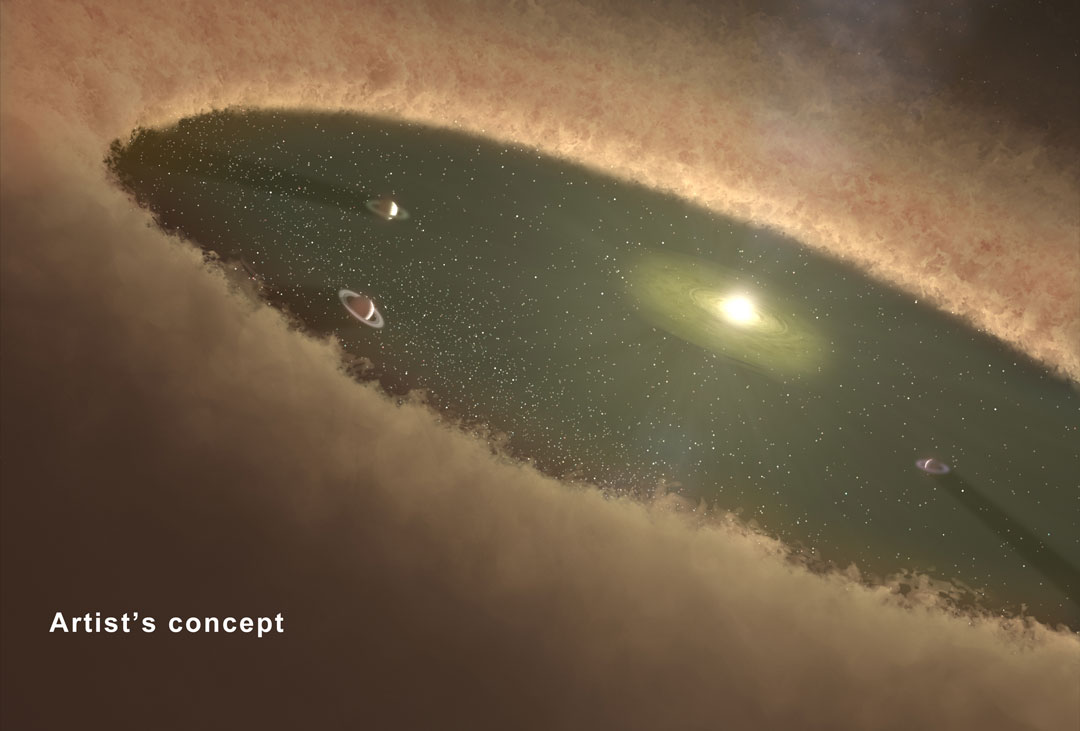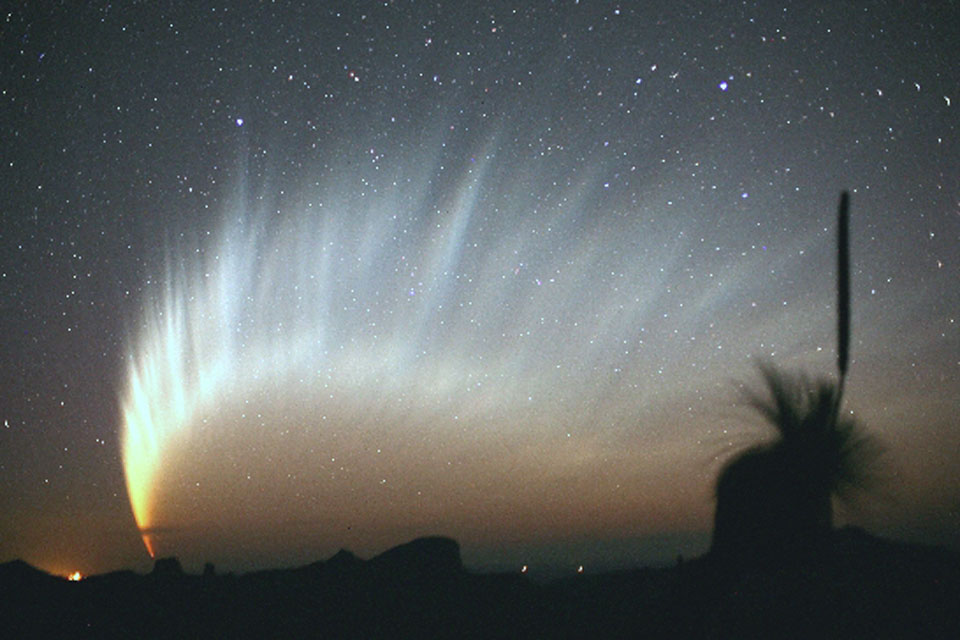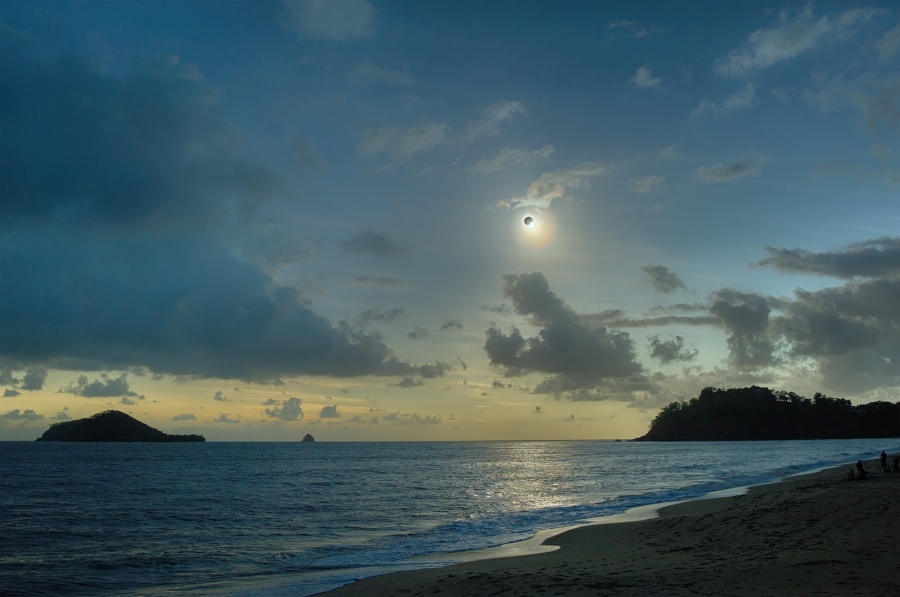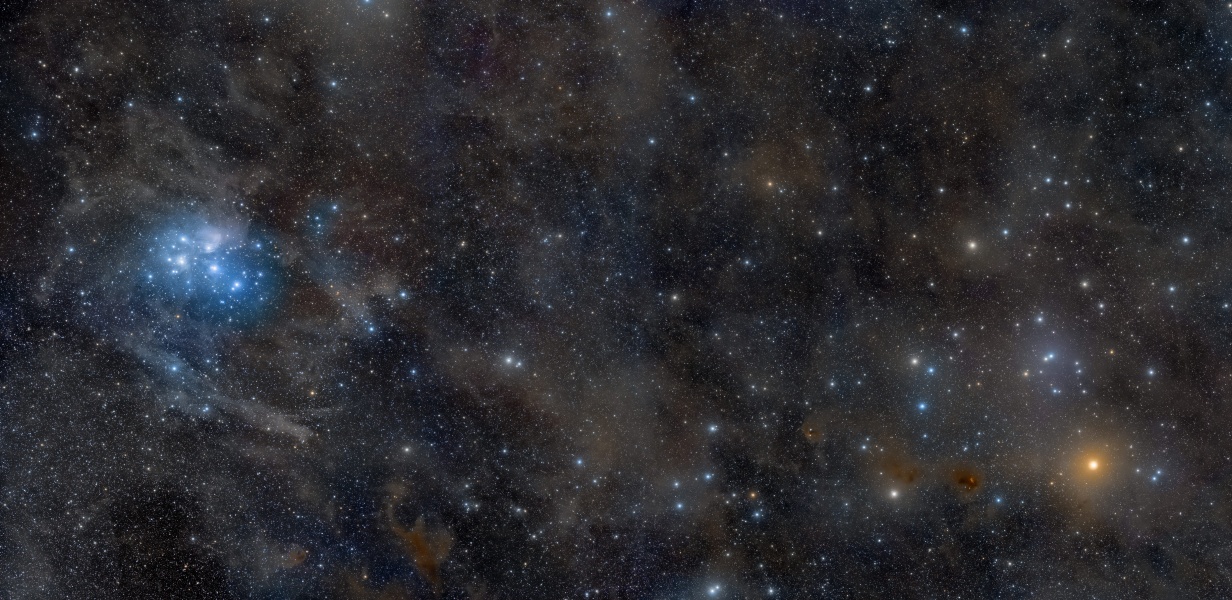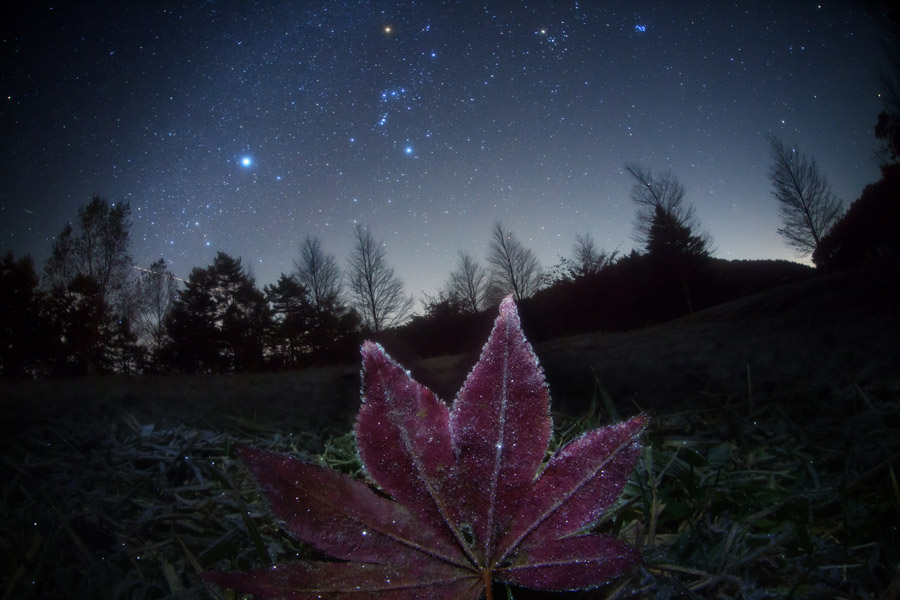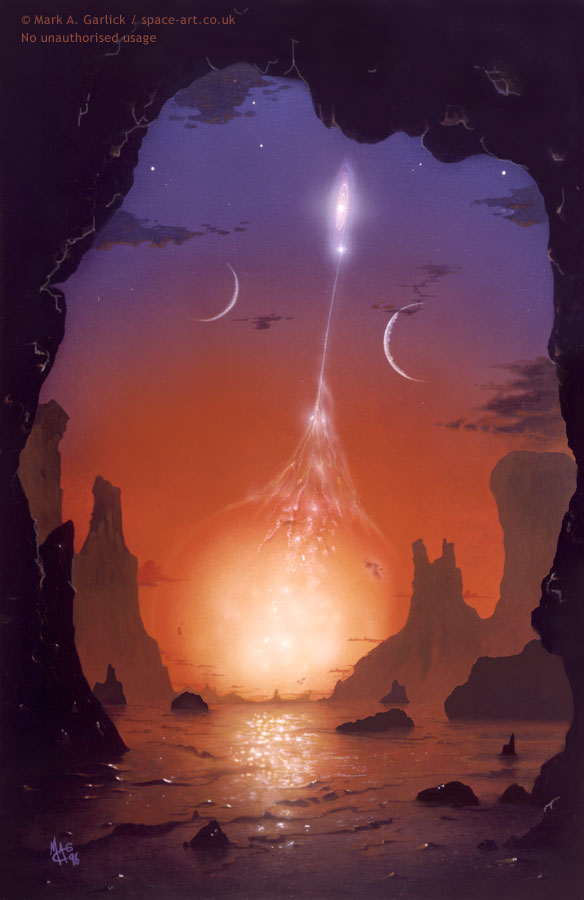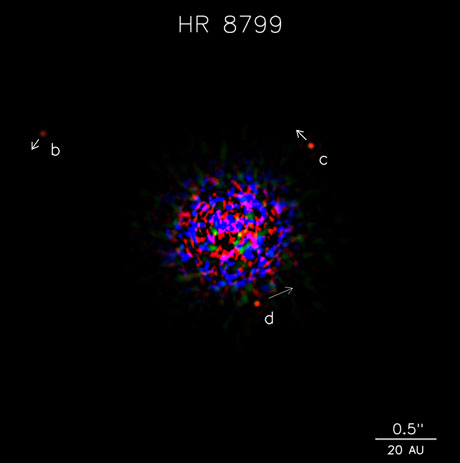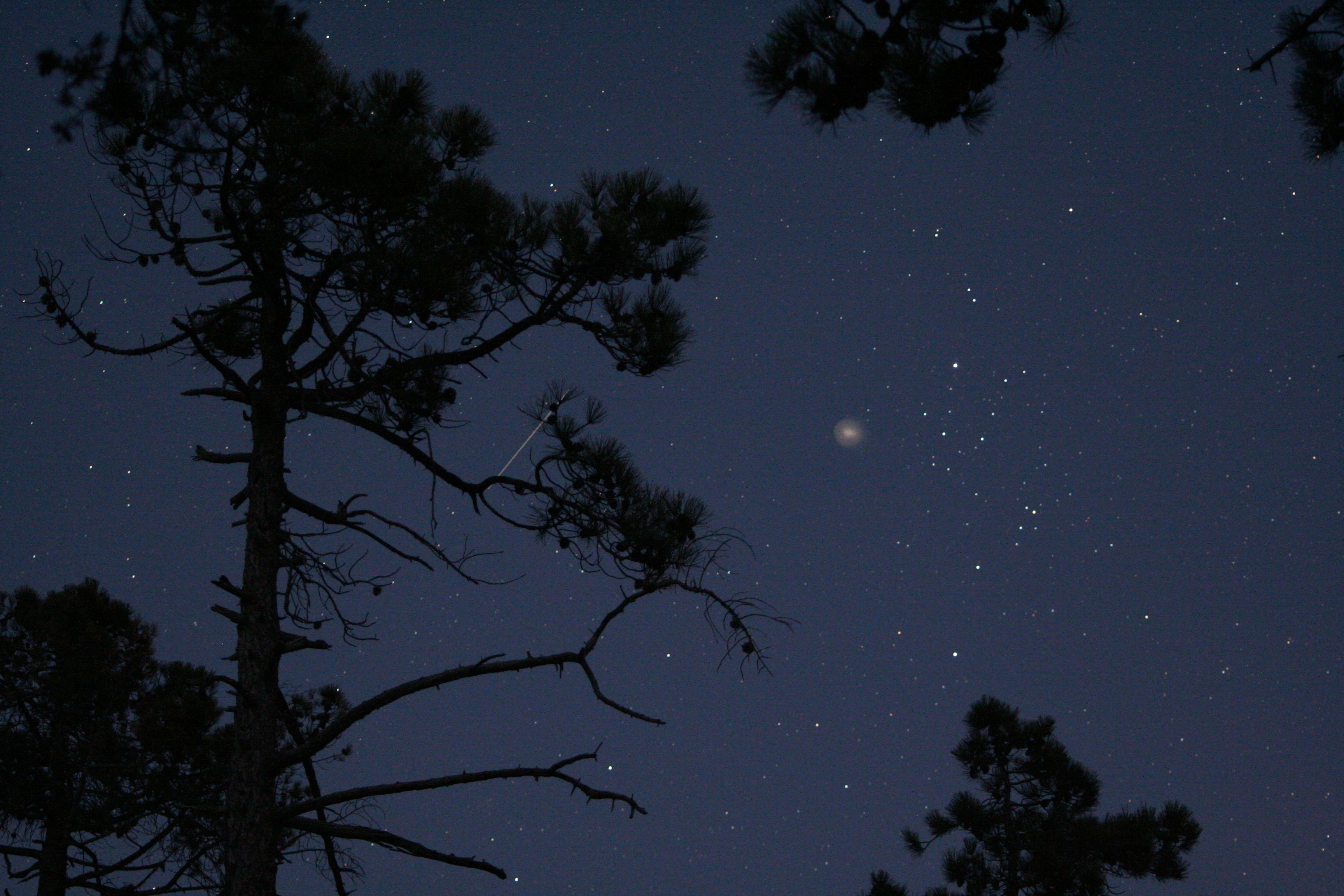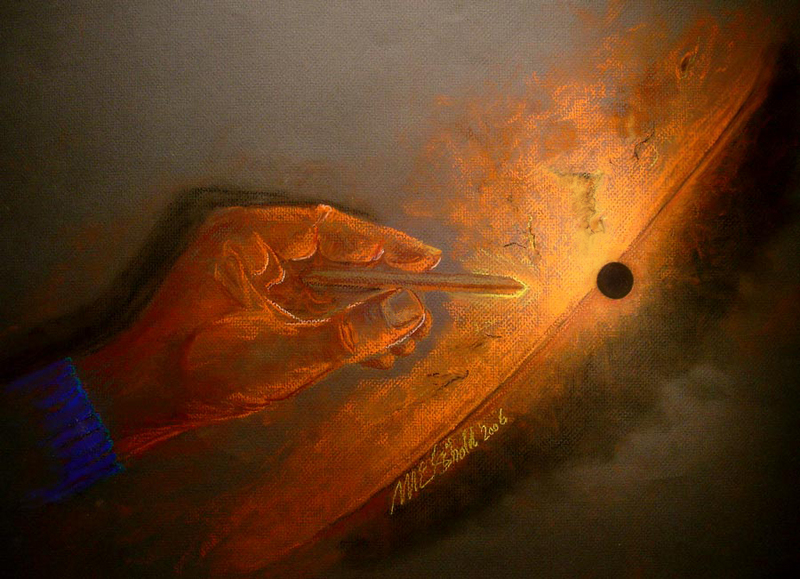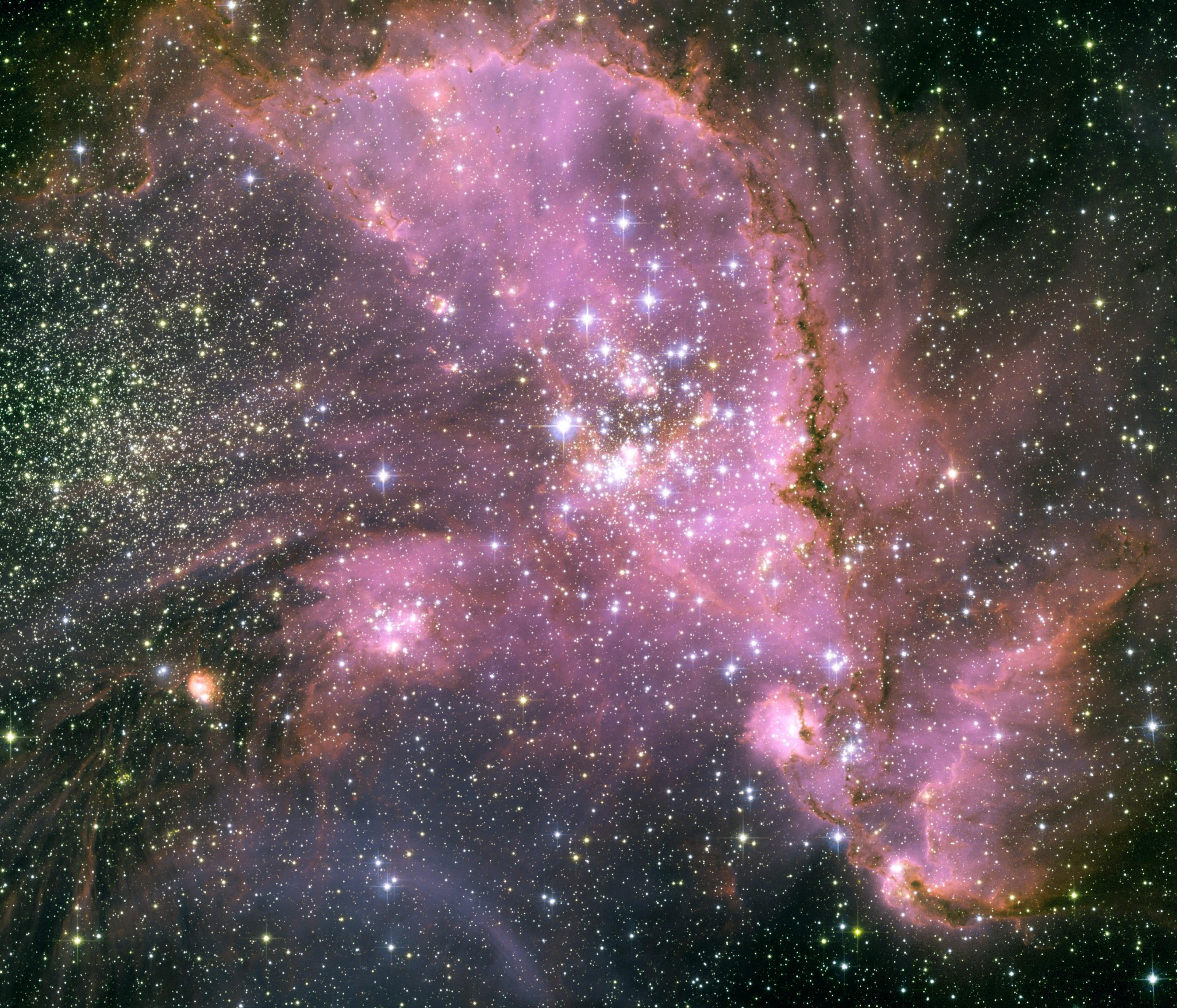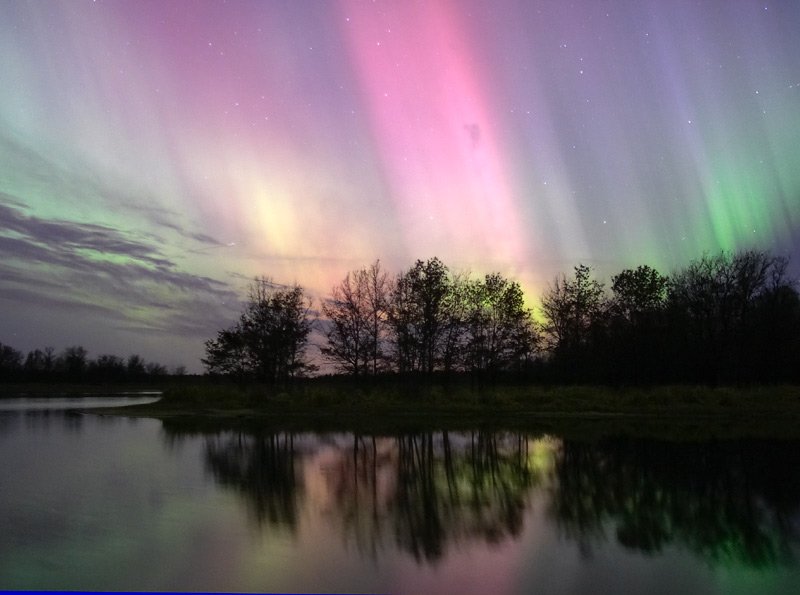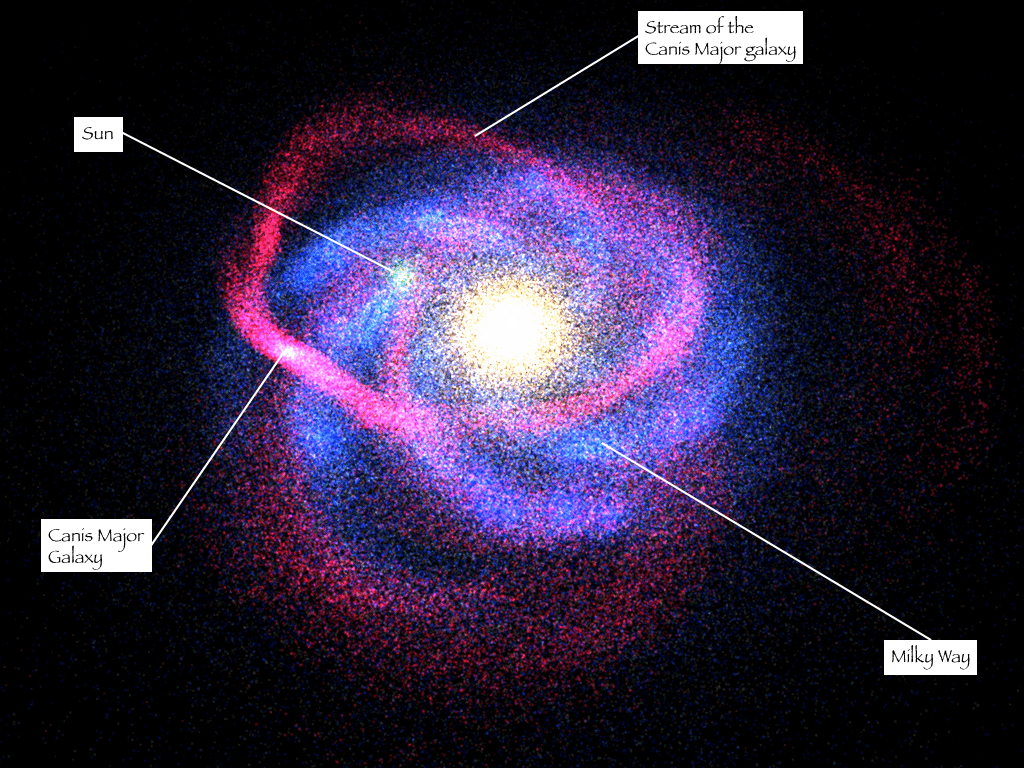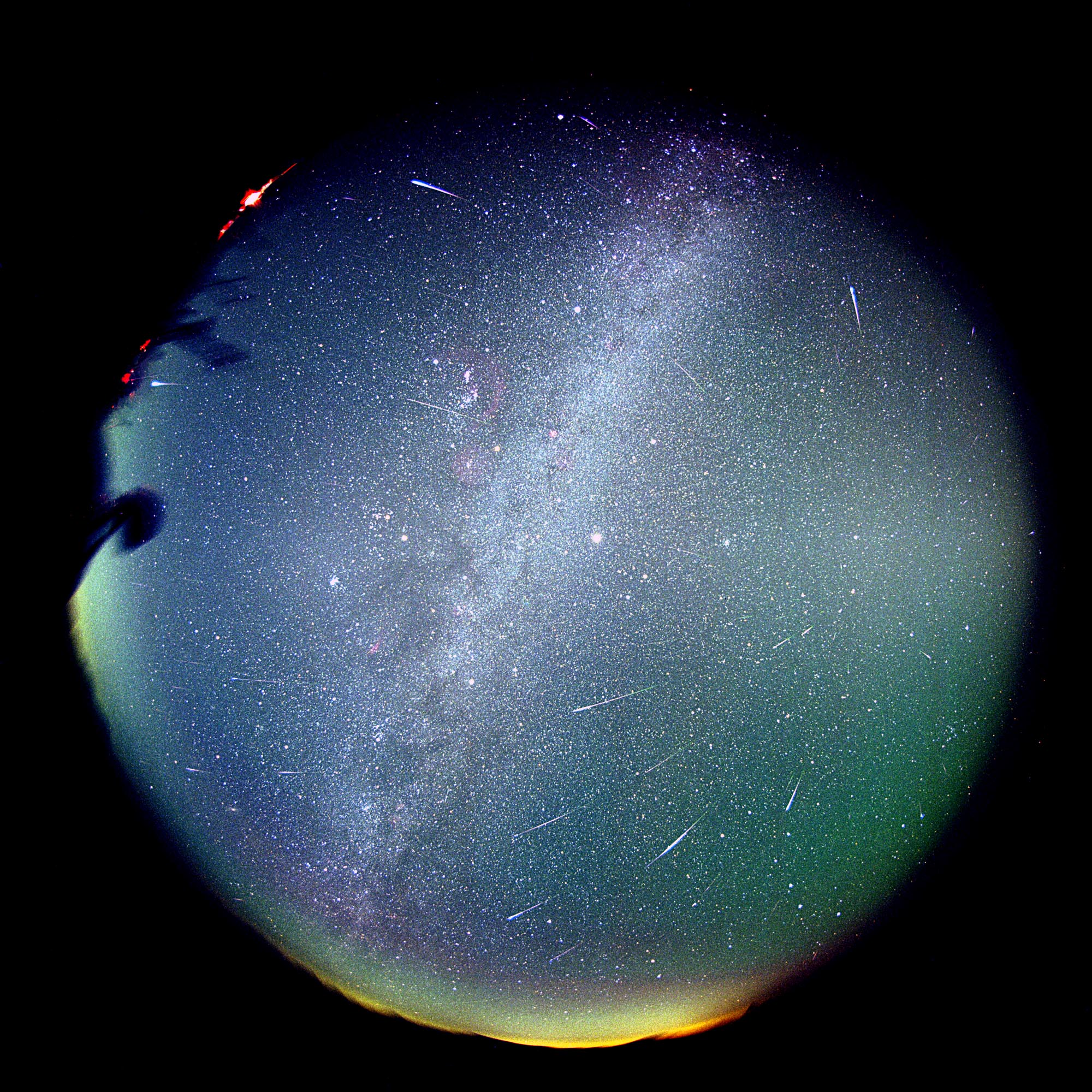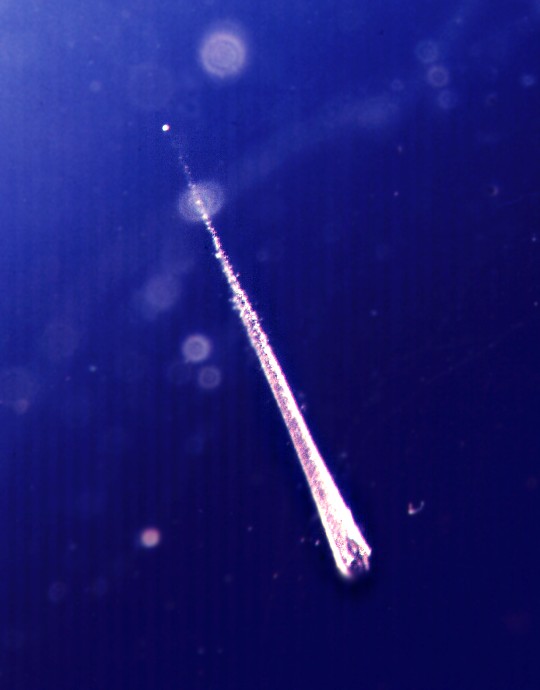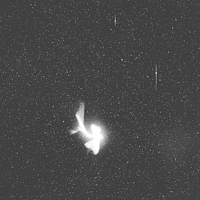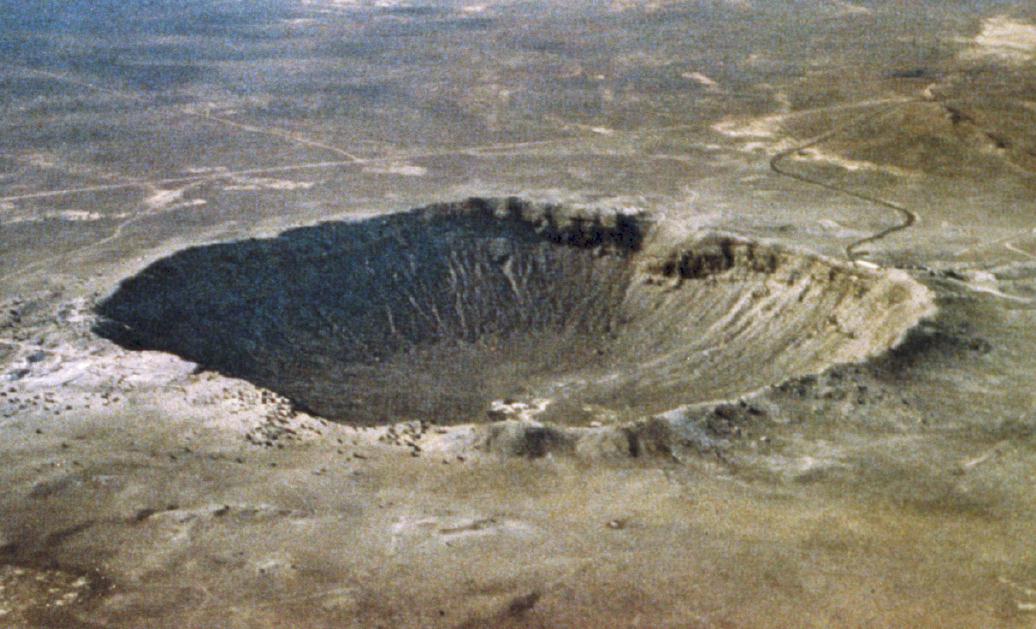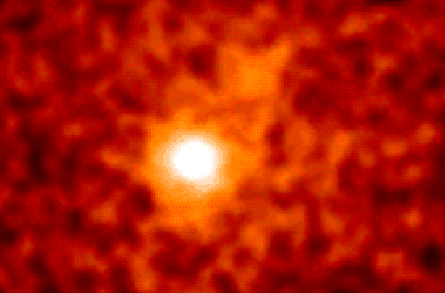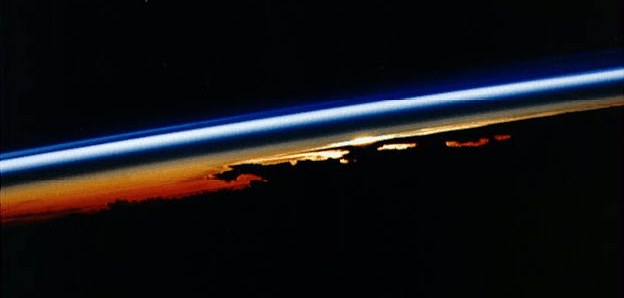| << Previous | Index | Next >> |
2014 What do other star systems look like? To help find out, astronomers are carrying out detailed observations of nearby stars in infrared light to see which have dust disks that might be forming planets. Observations by NASA's Spitzer Space Telescope and ESA's Herschel Space Observatory have found that planetary system HD 95086 has two dust disks: a hot one near the parent star and a cooler one farther out. An artist's illustration of how the system might appear is featured here, including hypothetical planets with large rings that orbit between the disks. The planets may have created the large gap between the disks by absorbing and deflecting dust with their gravity. HD 95086 is a blue star about 60 percent more massive than our Sun that lies about 300 light years from Earth and is visible with binoculars toward the constellation of Carina. Studying the HD 95086 system may help astronomers better understand the formation and evolution of our own Solar System as well as the Earth.
2013 Comet McNaught, the Great Comet of 2007, grew a spectacularly long and filamentary tail. The magnificent tail spread across the sky and was visible for several days to Southern Hemisphere observers just after sunset. The amazing tail showed its greatest extent on long-duration, wide-angle camera exposures. During some times, just the tail itself estimated to attain a peak brightness of magnitude -5 (minus five), was caught by the comet's discoverer in the above image just after sunset in January 2007 from Siding Spring Observatory in Australia. Comet McNaught, the brightest comet in decades, then faded as it moved further into southern skies and away from the Sun and Earth. Within the next two weeks of 2013, rapidly brightening Comet ISON might sprout a tail that rivals even Comet McNaught.
2012 A dark Sun hung over Queensland, Australia on Wednesday morning during a much anticipated total solar eclipse. Storm clouds threatened to spoil the view along the northern coast, but minutes before totality the clouds parted. Streaming past the Moon's edge, the last direct rays of sunlight produced a gorgeous diamond ring effect in this scene from Ellis Beach between Cairns and Port Douglas. Winking out in a moment, the diamond didn't last forever though. The area was plunged into darkness for nearly 2 minutes as the Moon's shadow swept off shore toward Australia's Great Barrier Reef and out into the southern Pacific. Ranging from 1/4000 to 1/15 seconds long, five separate exposures were blended in the image to create a presentation similar to the breathtaking visual experience of the eclipse.
2011 This cosmic vista stretches almost 20 degrees across the gentle constellation Taurus. It begins at the Pleiades and ends at the Hyades, two of the best known star clusters in planet Earth's sky. At left, the lovely Pleiades star cluster is about 400 light-years away. In a familiar celestial scene, the cluster stars shine through dusty clouds that scatter blue starlight. At right, the V-shaped Hyades cluster looks more spread out compared to the compact Pleiades and lies much closer, 150 light-years distant. Of course, the Hyades cluster stars seem anchored by bright Aldebaran, a red giant star with a yellowish appearance. But Aldebaran actually lies only 65 light-years away, by chance along the line of sight to the Hyades cluster. Faint dust clouds found near the edge of the Taurus Molecular Cloud are also evident throughout the remarkable 12 panel mosaic. The wide field of view includes the youthful star T Tauri and Hind's variable nebula about four degrees left of Aldebaran on the sky.
2010 Sometimes, you can put some night sky in your art. Captured above Japan earlier this month, a picturesque night sky was photographed behind a picturesque frosted leaf. The reflecting ice crystals on the leaf coolly mimic the shining stars far in the background. The particular background sky on this 48-second wide angle exposure, however, might appear quite interesting and familiar. On the far left, although hard to find, appears a streaking meteor. Below and to the right of the meteor appears a longer and brighter streak of an airplane. The bright star on the left is the dog-star Sirius, the brightest star on the night sky. To Sirius' right appears the constellation of Orion, including the three linear belt stars below the red giant Betelgeuse. The bright patch of light further to the right is the Pleiades open star cluster. Similar views including the constellation Orion can be seen above much of the northern hemisphere for the next several months, although you might have to provide your own leaf.
2009 Will this dawn bring another nova? Such dilemmas might be pondered one day by future humans living on a planet orbiting a cataclysmic variable binary star system. Cataclysmic variables involve gas falling from a large star onto an accretion disk surrounding a massive but compact white dwarf star. Explosive cataclysmic events such as a dwarf nova can occur when a clump of gas in the interior of the accretion disk heats up past a certain temperature. At that point, the clump will fall more quickly onto the white dwarf and land with a bright flash. Such dwarf novas will not destroy either star, and may occur irregularly on time scales from a few days to tens of years. Although a nova is much less energetic than a supernova, if recurrent novas are not violent enough to expel more gas than is falling in, mass will accumulate onto the white dwarf star until it passes its Chandrasekhar limit. At that point, a foreground cave may provide little protection, as the entire white dwarf star will explode in a tremendous supernova.
2008 How common are planetary systems like our own Solar System? In the twelve years previous to 2008, over 300 candidate planetary systems have been found orbiting nearby stars. None, however, were directly imaged, few showed evidence for multiple planets, and many had a Jupiter-sized planet orbiting inside the orbit of Mercury. Last week, however, together with recent images of Fomalhaut b, the above picture was released showing one of first confirmed images of planets orbiting a distant Sun-like star. HR 8799 has a mass about 1.5 times that of our own Sun, and lies about 130 light years from the Sun -- a distance similar to many stars easily visible in the night sky. Pictured above, a 10-meter Keck telescope in Hawaii captured in infrared light three planets orbiting an artificially obscured central star. The 8-meter Gemini North telescope captured a similar image. Each planet likely contains several times the mass of Jupiter, but even the innermost planet, labelled d, has an orbital radius near the equivalent of the Sun- Neptune distance. Although the HR 8799 planetary system has significant differences with our Solar System, it is a clear demonstration that complex planetary systems exist, systems that could conceivable contain an Earth-like planet.
2007 With pine trees in dim silhouette, this skyscape from Breil-sur-Roya in southern France was captured on November 11. In the early evening scene, a satellite seems to streak through the branches, while bright, round, fuzzy Comet Holmes appears to lie just beyond them, near the stars of the constellation Perseus. Mirfak, alpha star of Perseus, is the brightest star above the comet and to the right. Next Monday (November 19), Holmes will be close enough to Mirfak to view the star through the remarkable comet's expanding coma. Recent measurements place the dusty coma's diameter at about 1.4 million kilometers, even larger than the Sun.
2006 The sight of Mercury's tiny round disk drifting slowly across the face of the Sun inspired and entertained many denizens of planet Earth last week. In fact, artist and astronomer Mark Seibold viewed both the 1999 and 2006 transits of the solar system's innermost planet through solar filtered telescopes and composed this rendering of Mercury "hovering in the photosphere" near the edge of an enormous solar disk. The original work is a 23 by 17 inch pastel sketch. While the artist's hand is creatively superimposed, Seibold concentrated on offering an impression of Mercury's silhouette, surrounded by shadings reflecting his visual experience that are not easily captured in photographic exposures. Of course, before the age of cameras drawings were more widely used to record telescopic observations of sunspots and planetary transits.
2005 Star cluster NGC 346 is embedded in the largest star forming region in the Small Magellanic Cloud, some 210,000 light-years distant. The massive stars of NGC 346 are short lived, but very energetic. Their winds and radiation sweep out an interstellar cavern in the gas and dust cloud about 200 light-years across, triggering star formation and sculpting the region's dense inner edge. Cataloged as N66, the star forming region also appears to contain a large population of infant stars. A mere 3 to 5 million years old and not yet burning hydrogen in their cores, the infant stars are strewn about the embedded star cluster. In the false-color Hubble Space Telescope image, visible and near-infrared light are seen as blue and green, while light from atomic hydrogen emission is red.
2004 The auroral displays of the past week are being reported as some of the most beautiful in memory. In particular, impressive auroral bands fanned out over much of eastern North America after sunset on November 8. The multicolored aurora pictured above was caught reflecting in one of the many small lakes in central Wisconsin near that time. Continued solar activity might create more aurora visible over the next few nights as the Leonids meteor shower peaks.
2003 What is the closest galaxy to the Milky Way? The new answer to this old question is the Canis Major dwarf galaxy. For many years astronomers thought the Large Magellan Cloud (LMC) was closest, but its title was supplanted in 1994 by the Sagittarius dwarf galaxy. Recent measurements indicate that the Canis Major dwarf is only 42,000 light years from the Galactic center, about three quarters of the distance to the Sagittarius dwarf and a quarter of the distance to the LMC. The discovery was made in data from the 2MASS-sky survey, where infrared light allows a better view through our optically opaque Galactic plane. The labeled illustration above shows the location of the newly discovered Canis Major dwarf and its associated tidal stream of material in relation to our Milky Way Galaxy. The Canis Major dwarf and other satellite galaxies are slowly being gravitationally ripped apart as they travel around and through our Galaxy.
2002 Is Leo leaking? Leo, the famous sky constellation visible on the left of the above all-sky photograph, appears to be the source of all the meteors seen in last year's Leonids Meteor Shower. That Leonids point back to Leo is not a surprise - it is the reason that this November meteor shower is called the Leonids. Sand-sized debris expelled from Comet Tempel-Tuttle follows a well-defined orbit about our Sun, and the part of the orbit that approaches Earth is superposed in front of the constellation Leo. Therefore, when Earth crosses this orbit, the radiant point of falling debris appears in Leo. Over 100 bright meteors can be seen in the above half-hour exposure. The intensity of the Leonid Meteor Shower in 2002 is uncertain but may approach one per second for some locations on November 18 and 19.
2001 This carrot-shaped track is actually little more than 5 hundredths of an inch long. It is the trail of a meteroid through the high-tech substance aerogel exposed to space by the shuttle launched EURECA (European Recoverable Carrier) spacecraft. Like those in the ongoing Leonid meteor shower, this meteoroid is about a thousandth of an inch in diameter. It is visible where it came to rest, just beyond the tip of the carrot at the far right. Chemical analyses of interplanetary dust particles similar to this one suggest that some of them may be bits of comets and thus represent samples of material from the early stages of the formation of the Solar System.
2000 Such beautiful things begin as grains of sand. Locked in an oyster a granule grows into an iridescent pearl, lustrous and lovely to behold. While hurtling through the atmosphere at 70 kilometers per second, a cosmic sand grain becomes an awe-inspiring meteor, its transient beauty displayed for any who care to watch. Framed perfectly between orange clouds at sunrise, this bright meteor trail was photographed from the Joshua Tree National Park in California, USA during the 1998 Leonid Meteor Shower. Appropriately titled "Leonid Sunrise", the picture was recorded on high-speed film (ASA 3200) with a 35mm camera. Its striking colors and grainy, textured appearance suggest a painting on canvas. Of course, you could see Leonid meteors at sunrise for yourself. With clear skies, your next chance is coming up ... tomorrow morning.
1999 Tonight, a lucky few may see a meteor explode. Over the next 36 hours the Earth will pass unusually close to debris expelled from Comet Tempel-Tuttle, causing many sand-sized particles from this comet to enter and burn up in the Earth's atmosphere. This yearly phenomenon is known as the Leonids Meteor Shower, but the location the Earth passes through this year holds promise to provide particularly high activity. The 1998 Leonids was noteworthy for its many bright meteors. In the above slow-loading sequence, a 1998 Leonid was caught exploding over Los Alamos, New Mexico. In the last one-minute exposure, another Leonid streaks past. If tonight is clear, just grab a lawn chair and a warm jacket, go outside, and look up!
1998 What created this huge space bubble? A massive star that is not only bright and blue, but also emitting a fast stellar wind of ionized gas. The Bubble Nebula is actually the smallest of three bubbles surrounding massive star BD+602522, and part of gigantic bubble network S162 created with the help of other massive stars. As fast moving gas expands off BD+602522, it pushes surrounding sparse gas into a shell. The energetic starlight then ionizes the shell, causing it to glow. The Bubble Nebula, also known as NGC 7635, is about 10 light-years across and visible with a small telescope towards the constellation of Cassiopeia.
1997 What happens when a meteor hits the ground? Usually nothing much, as most meteors are small, and indentations they make are soon eroded away. 49,000 years ago, however, a large meteor created Barringer Meteor Crater in Arizona, pictured above. Barringer is over a kilometer across. In 1920, it was the first feature on Earth to be recognized as an impact crater. Today, over 100 terrestrial impact craters have been identified. Early this morning, the Leonid Meteor Shower reaches its peak, although no impacts of this magnitude are expected.
1996 The bright object in the center of the false color image above is quasar 3C279 viewed in gamma-rays, photons with more than 40 million times the energy of visible light. Like all quasars, 3C279 is a nondescript, faint, starlike object in the visible sky. Yet, in June of 1991 a gamma-ray telescope onboard NASA's orbiting Compton Gamma Ray Observatory unexpectedly discovered that it was one of the brightest objects in the gamma-ray sky. Shortly after this image was recorded the quasar faded from view at gamma-ray energies. Astronomers are still trying to understand what causes these enigmatic objects to flare so violently. Another quasar, 3C273, is faintly visible above and to the right of center.
1995 Sunrise seen from low Earth orbit by the shuttle astronauts can be very dramatic indeed (and the authors apologize to Hemingway for using his title!). In this breathtaking view, the Sun is just visible peaking over towering anvil shaped storm clouds whose silhouetted tops mark the upper boundary of the troposphere, the lowest layer of planet Earth's atmosphere. Sunlight filtering through suspended dust causes this dense layer of air to appear red. In contrast, the blue stripe marks the stratosphere, the tenuous upper atmosphere, which preferentially scatters blue light.
| << Previous | Index | Next >> |
